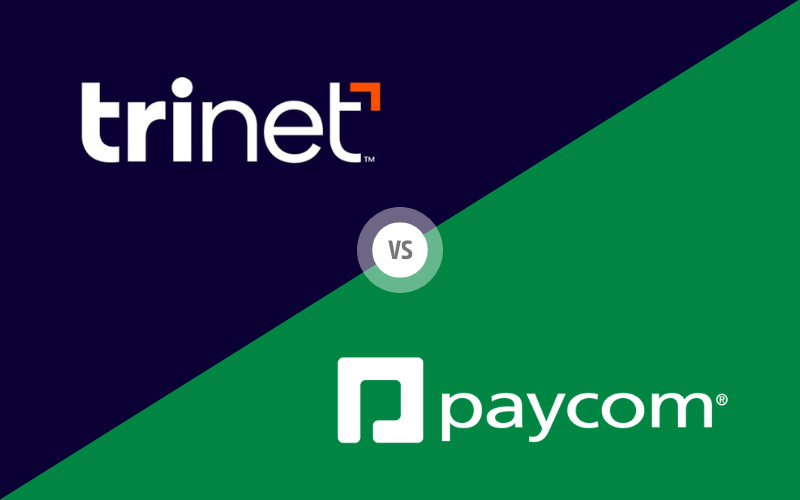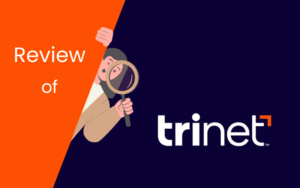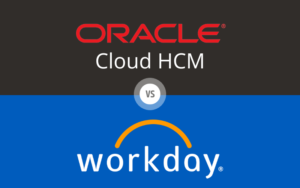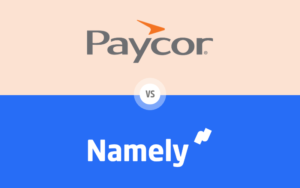In this detailed comparison of TriNet vs Paycom, we focus on choosing the right Human Capital Management (HCM) software, which is crucial for the efficient management of workforce operations and strategic HR planning. We explore key aspects such as User Interface and User Experience, Core HR Functions, Payroll Management, and more to help you determine which software best fits your organization’s needs. This blog post will provide you with comprehensive insights into integration capabilities, customer support, pricing, and user feedback, enabling you to make an informed decision between these two leading HCM platforms. Whether you are looking to enhance your HR functionalities, streamline processes, or improve employee engagement and productivity, understanding the strengths and limitations of TriNet and Paycom is essential. Let’s dive into the details to see how these systems compare and which might be the right choice for your business.
Table of Contents
User Interface and User Experience
When assessing TriNet vs Paycom, it’s critical to delve into their user interface (UI) and user experience (UX). Each platform is designed to facilitate HR operations, yet they take distinct paths in their approach to UI and UX.

TriNet User Interface and User Experience
TriNet stands out with its modern, user-focused design that emphasizes ease of use and efficiency. The platform’s dashboard is streamlined and intuitive, enabling users to swiftly navigate and manage HR tasks.
Key Features of TriNet UI/UX:
- Customization: Users can adapt the dashboard with widgets and shortcuts, streamlining daily tasks and boosting productivity.
- Visual Design: Features a modern, clean aesthetic that enhances user engagement and satisfaction.
- Ease of Use: The interface is designed for simplicity, helping new users to quickly become proficient with minimal training.
Paycom User Interface and User Experience
Paycom caters to larger organizations with its robust interface designed for scalability and comprehensive functionality, albeit with a potentially steeper learning curve.
Key Features of Paycom UI/UX:
- Functionality: Equipped to handle complex, detailed HR management tasks suitable for large enterprises.
- Navigation: Despite its extensive features, the interface is organized logically, facilitating easy access to tools and information.
- Professional Design: Focuses on functional efficiency, sporting a straightforward layout that prioritizes utility over aesthetic concerns.
Comparison and Conclusion
In the showdown between TriNet vs Paycom, the choice between them depends on the specific needs of your organization. TriNet is excellent for those seeking a straightforward, visually appealing interface that makes HR management feel effortless. Paycom, on the other hand, is suited for larger enterprises needing a powerful, feature-dense system capable of managing intricate HR functions.
The decision between TriNet and Paycom will largely hinge on whether you prioritize a clean, user-friendly design or extensive functionality for complex HR operations.
Core HR Functions
Evaluating the core HR functions is essential when comparing TriNet vs Paycom. These functions are the backbone of any HCM software, facilitating essential HR tasks such as employee data management, organizational structures, and basic HR processes.

TriNet Core HR Functions
TriNet provides a comprehensive suite designed to manage all aspects of employee operations, from hiring to retirement. Its core HR capabilities are centered around simplifying complex processes and enhancing strategic decision-making.
Key Features of TriNet Core HR Functions:
- Employee Central: Acts as a complete system of record for all workforce-related information, integrating seamlessly with other modules to manage everything from payroll to benefits and time tracking.
- Global Compliance: Ensures adherence to local and global regulations with built-in features that adapt to varying legal requirements across different geographies.
- Robust Workflows: Automates and streamlines HR processes, reducing manual effort and improving accuracy and efficiency.
Paycom Core HR Functions
Paycom stands out with its ability to scale and adapt to the complex needs of large enterprises. It offers a versatile and dynamic approach to core HR functions, aimed at supporting global operations.
Key Features of Paycom Core HR Functions:
- Comprehensive HR Database: Provides a detailed view of employee records, supporting detailed analytics and insights for strategic planning.
- Flexible Organizational Management: Offers tools for managing diverse organizational structures and supports dynamic adjustments as the organization evolves.
- Advanced Security Features: Protects sensitive employee data with robust security protocols and compliance with international data protection regulations.
Comparison and Conclusion
In the matchup of TriNet vs Paycom, both platforms offer robust core HR functions but target slightly different needs. TriNet is ideal for organizations that require a user-friendly, comprehensive solution that integrates seamlessly across HR disciplines, making it suitable for mid-sized to large businesses. On the other hand, Paycom offers exceptional scalability and flexibility, making it perfect for large or globally diverse organizations that face complex HR challenges.
Ultimately, the choice between TriNet and Paycom for core HR functions will depend on your organization’s size, complexity, and specific HR needs. Each platform provides powerful tools to streamline operations and enhance the strategic impact of HR within the business.
Payroll Management
A critical aspect of any HCM solution is its payroll management capabilities. When comparing TriNet vs Paycom, it’s essential to understand how each system handles payroll processes, from basic payroll calculations to complex regulatory compliance and reporting.

TriNet Payroll Management
TriNet offers a robust payroll solution that integrates seamlessly with its Core HR module, providing an all-in-one approach to manage payroll alongside other HR functions.
Key Features of TriNet Payroll Management:
- Comprehensive Integration: Seamlessly integrates with Employee Central, ensuring that all employee data directly influences payroll calculations without the need for duplicate data entry.
- Global Payroll Capabilities: Supports payroll operations across more than 40 countries, helping multinational companies manage local compliance and reporting requirements efficiently.
- Real-time Payroll Processing: Enables real-time calculations, allowing for immediate previews of payroll results, which helps in quick decision-making and error rectification.
Paycom Payroll Management
Paycom’s payroll management is designed to handle complex payroll requirements with precision and flexibility, making it suitable for organizations of various sizes and with operations in multiple countries.
Key Features of Paycom Payroll Management:
- Scalable Solutions: Offers scalable payroll solutions that grow with your business, from small teams to large multinational corporations.
- Regulatory Compliance: Automatically updates payroll systems with the latest legal changes in each country, reducing the risk of compliance issues.
- Advanced Reporting: Provides detailed analytics and reporting capabilities that enable deeper insights into payroll operations and their impact on overall business finances.
Comparison and Conclusion
In comparing TriNet vs Paycom for payroll management, both platforms offer strong features that cater to diverse organizational needs. TriNet is particularly well-suited for businesses looking for tight integration between payroll and other HR processes, ensuring consistency and accuracy across the board. Its real-time processing capability is also a significant advantage for organizations needing immediate payroll previews.
On the other hand, Paycom excels in managing payroll for complex, diverse, and rapidly changing global environments. Its robust compliance and reporting tools make it ideal for organizations that prioritize scalability and regulatory adherence in their payroll operations.
Choosing between TriNet and Paycom will depend on your organization’s specific payroll needs, especially regarding global operations, regulatory demands, and integration with broader HR functions. Both systems are equipped to provide comprehensive payroll management but do so with distinct strengths and focuses.
Time and Attendance Tracking
Time and attendance tracking is a vital function within any HCM platform, impacting everything from payroll processing to employee productivity management. In this segment, we explore how TriNet vs Paycom handle time and attendance tracking, focusing on the efficiency and accuracy of each system.

TriNet Time and Attendance Tracking
TriNet provides a comprehensive solution for time and attendance that integrates seamlessly with its payroll and HR modules. This integration helps ensure accurate data flow across the system, enhancing both operational efficiency and compliance.
Key Features of TriNet Time and Attendance Tracking:
- Employee Self-Service: Empowers employees to log their own time and attendance through a user-friendly interface, which helps ensure data accuracy and reduce administrative workload.
- Integrated Workforce Management: Links directly with other HR functions like payroll and benefits, ensuring that time data influences all relevant areas without manual intervention.
- Compliance Management: Automatically updates to comply with local labor laws and regulations, minimizing the risk of non-compliance penalties.
Paycom Time and Attendance Tracking
Paycom offers robust time and attendance tracking capabilities designed to accommodate organizations with complex needs, including those with multiple locations and varying shift patterns.
Key Features of Paycom Time and Attendance Tracking:
- Advanced Scheduling: Supports complex shift patterns and workforce scheduling, making it suitable for industries with non-standard work hours.
- Real-Time Analytics: Provides real-time insights into attendance data, allowing managers to make informed decisions quickly and address staffing issues proactively.
- Global Support: Caters to multinational companies by accommodating diverse regulatory requirements and providing localized support for various regions.
Comparison and Conclusion
When comparing TriNet vs Paycom in the area of time and attendance tracking, both platforms offer robust tools that can significantly benefit an organization. TriNet is ideal for businesses looking for a tightly integrated system that allows easy employee involvement and ensures compliance through automatic updates. It’s particularly well-suited to companies prioritizing straightforward, efficient operations.
Conversely, Paycom excels in environments that require advanced scheduling capabilities and comprehensive, real-time analytics. Its global support makes it a strong candidate for multinational corporations dealing with varied workforce regulations.
Choosing between TriNet and Paycom will largely depend on your organization’s specific requirements concerning scalability, complexity of scheduling needs, and the level of integration desired with other HR processes. Each system offers distinctive benefits that cater to different organizational needs and priorities.
Benefits Administration
Effective benefits administration is a critical aspect of Human Capital Management (HCM) systems, enhancing employee satisfaction and retention by efficiently managing benefits packages. This discussion will compare the benefits administration capabilities of TriNet vs Paycom, highlighting how each system can support diverse organizational needs.

TriNet Benefits Administration
TriNet offers a streamlined approach to benefits administration, designed to simplify the complexities associated with managing various employee benefits. Its integration with other HR modules ensures a cohesive management experience.
Key Features of TriNet Benefits Administration:
- Comprehensive Benefits Coverage: Manages a wide array of benefits including health, dental, retirement plans, and more, ensuring employees have access to their benefits in one centralized location.
- Employee Self-Service Portal: Allows employees to easily access and manage their benefits, make selections during open enrollment periods, and update their preferences as personal circumstances change.
- Automated Benefits Management: Streamlines the enrollment process and ensures that all benefits selections are automatically updated across related HR systems, reducing administrative burden and minimizing errors.
Paycom Benefits Administration
Paycom provides robust benefits administration capabilities, with advanced tools that cater to the needs of large and globally dispersed organizations. It offers flexibility in managing an extensive range of benefits packages tailored to diverse employee populations.
Key Features of Paycom Benefits Administration:
- Flexible Benefits Configuration: Offers the ability to customize benefits packages to meet the specific needs of different employee groups, enhancing personalization and employee satisfaction.
- Integrated Analytics: Equipped with analytics tools that provide insights into benefits utilization and costs, helping HR managers make data-driven decisions to optimize benefits offerings.
- Global Compliance Support: Ensures compliance with local and international benefits regulations, which is critical for multinational organizations.
Comparison and Conclusion
The choice between TriNet vs Paycom when it comes to benefits administration will largely depend on the specific needs of your organization. TriNet is highly effective for companies seeking a user-friendly, integrated solution that simplifies benefits management and enhances employee engagement through easy-to-use self-service options. Its automated processes also help ensure accuracy and consistency across HR systems.
On the other hand, Paycom is suited for larger organizations or those with complex benefits requirements, particularly those operating on a global scale. Its customizable benefits configuration and powerful analytics capabilities allow for a tailored approach that can adapt to the unique needs of a diverse workforce.
Both TriNet and Paycom offer powerful solutions for benefits administration, but the right choice will depend on your organization’s size, complexity, and the strategic importance of offering a diverse and adaptable benefits package to your employees.
Performance Management
Performance management is a pivotal component of any HCM system, helping organizations to align employee activities with strategic goals and improve overall productivity. This section compares the performance management features of TriNet vs Paycom, focusing on how each system supports continuous performance improvement and effective employee evaluation.

TriNet Performance Management
TriNet provides a comprehensive performance management module that facilitates ongoing feedback and goal management, supporting a culture of continuous improvement and engagement.
Key Features of TriNet Performance Management:
- Continuous Feedback: Provides tools for real-time feedback and coaching, allowing managers and peers to give immediate responses to employees, which can be integrated into the performance assessment process.
- Goal Management: Enables employees and managers to set, track, and update performance goals throughout the year, aligning individual objectives with company-wide strategies.
- Performance Assessments: Automates the performance review process with customizable templates that can accommodate various evaluation methods, ensuring a consistent and objective approach to employee performance reviews.
Paycom Performance Management
Paycom offers a versatile and robust performance management system designed to support complex organizational structures and diverse workforce needs, with a strong emphasis on scalability and configurability.
Key Features of Paycom Performance Management:
- Advanced Goal Setting: Supports complex goal hierarchies that can link individual achievements directly to high-level organizational goals, facilitating strategic alignment across all levels of the company.
- Detailed Analytics: Integrates powerful analytics to track performance trends and outcomes, providing insights that help managers make informed decisions about talent management and development.
- Flexible Review Cycles: Allows organizations to configure performance review cycles and processes to fit their specific needs, supporting a variety of review types, from annual reviews to project-based or 360-degree feedback sessions.
Comparison and Conclusion
In the comparison of TriNet vs Paycom in performance management, both platforms offer powerful tools designed to enhance the way organizations assess and develop their workforce. TriNet is particularly effective for businesses that prioritize a user-friendly, straightforward approach that integrates real-time feedback and goal management into everyday work processes. This system is ideal for fostering a proactive performance culture where continuous feedback is a central component.
Conversely, Paycom is suitable for larger or more complex organizations that require robust configurability and detailed analytical tools to manage performance across diverse global operations. Its ability to support various review types and complex goal structures makes it a good fit for enterprises that need a highly adaptable performance management system.
Choosing between TriNet and Paycom for performance management will largely depend on the specific needs of your organization, such as the scale of operations, the complexity of performance review processes, and the strategic importance of integrating detailed analytics in performance management. Both systems offer robust capabilities but cater to different organizational priorities and challenges.
Talent Management and Recruiting
Talent management and recruiting are critical functions of any HCM system, significantly impacting an organization’s ability to attract, develop, and retain top talent. In this analysis of TriNet vs Paycom, we will examine each platform’s capabilities to manage recruitment and talent effectively.

TriNet Talent Management and Recruiting
TriNet provides a holistic approach to talent management, incorporating robust recruiting tools designed to streamline the hiring process and improve the overall recruitment strategy.
Key Features of TriNet Talent Management and Recruiting:
- Recruiting Marketing: Offers tools to build a strong employer brand and engage with potential candidates before they apply, increasing the quality of applicant pools.
- Recruiting Management: Streamlines the entire recruitment process from job postings to candidate selection, with integrated tools that facilitate collaboration among hiring teams.
- Career Development Planning: Supports employee growth within the organization by identifying potential career paths and necessary skills, enhancing employee engagement and retention.
Paycom Talent Management and Recruiting
Paycom emphasizes a comprehensive talent management strategy with advanced recruiting features that cater to complex and diverse organizational needs, especially suitable for global operations.
Key Features of Paycom Talent Management and Recruiting:
- Global Talent Sourcing: Provides a global reach in recruitment efforts, supporting multiple languages and regional compliance, which is crucial for multinational corporations.
- Advanced Candidate Selection: Utilizes artificial intelligence to help refine candidate selection processes, ensuring that the most suitable applicants are identified and progressed through the hiring stages.
- Talent Review and Succession Planning: Integrates deep analytics to conduct thorough talent reviews and manage succession planning effectively, preparing the organization for future leadership needs.
Comparison and Conclusion
When comparing TriNet vs Paycom in the context of talent management and recruiting, both platforms offer comprehensive tools that can significantly enhance your organization’s ability to manage and grow its workforce. TriNet is particularly strong in providing an integrated, user-friendly solution that helps streamline the recruitment process while also supporting employee career development. Its focus on enhancing the candidate and employee experience makes it a great choice for organizations looking to boost engagement and retention.
On the other hand, Paycom is ideal for larger or more geographically diverse organizations that require a robust set of tools for global talent sourcing and advanced analytics. Its AI-driven candidate selection and detailed succession planning capabilities make it well-suited for enterprises that need a powerful, scalable solution to manage complex talent landscapes.
Choosing between TriNet and Paycom for talent management and recruiting will depend on your organization’s specific needs, such as the scale of your operations, the geographic diversity of your workforce, and the strategic importance of advanced analytics in your talent management processes. Both systems offer strong capabilities, but they cater to different organizational priorities and challenges.
Learning and Development
Learning and development is an integral function of any HCM system, helping organizations to foster a culture of continuous learning and innovation. In this comparison of TriNet vs Paycom, we will explore how each platform supports learning and development initiatives, from content delivery to skill assessment and tracking.

TriNet Learning and Development
TriNet offers a comprehensive learning and development module that enables organizations to create, deliver, and manage engaging learning experiences for their employees. It also integrates with other HR functions to align learning outcomes with performance and career goals.
Key Features of TriNet Learning and Development:
- Content Creation and Delivery: Provides tools to create and deliver various types of learning content, from e-learning courses to webinars and podcasts, supporting different learning styles and preferences.
- Learning Management System (LMS): Manages all aspects of the learning process, from enrollment and tracking to assessment and certification, ensuring a smooth and effective learning experience.
- Learning Integration: Aligns learning objectives and outcomes with other HR functions, such as performance management and career development, enhancing the impact of learning on employee growth and productivity.
Paycom Learning and Development
Paycom provides a robust learning and development solution that empowers organizations to design, deliver, and track personalized learning paths for their employees. It also leverages advanced analytics to measure the effectiveness and ROI of learning programs.
Key Features of Paycom Learning and Development:
- Personalized Learning Paths: Allows organizations to customize learning paths for each employee based on their role, skills, and goals, ensuring relevant and engaging learning experiences.
- Learning Content Library: Offers access to a vast library of learning content covering various topics and formats, from compliance training to leadership development.
- Learning Analytics: Provides detailed reports and dashboards that track and measure learning outcomes, such as completion rates, skill gaps, and learning ROI, helping to optimize learning strategies and investments.
Comparison and Conclusion
In the comparison of TriNet vs Paycom in learning and development, both platforms offer comprehensive solutions that can help organizations create a learning culture and enhance employee skills and performance. TriNet is particularly effective for organizations that seek a user-friendly, integrated solution that simplifies the learning process and aligns it with other HR functions. Its content creation and delivery tools are also ideal for organizations that want to create their own learning content and offer diverse learning options.
Conversely, Paycom is suitable for organizations that require a versatile and scalable solution that can support personalized learning paths and advanced analytics. Its content library and learning analytics tools are also ideal for organizations that want to access a wide range of learning content and measure the impact and ROI of their learning programs.
Choosing between TriNet and Paycom for learning and development will depend on your organization’s specific needs, such as the level of customization and integration you require, the type and variety of learning content you prefer, and the importance of analytics and reporting in your learning strategy. Both systems offer powerful capabilities, but they cater to different organizational priorities and challenges.
Reporting and Analytics
Reporting and analytics is a key function of any HCM system, helping organizations to gain insights into their workforce data and make informed decisions. In this comparison of TriNet vs Paycom, we will examine how each platform handles reporting and analytics, from data collection and integration to visualization and interpretation.

TriNet Reporting and Analytics
TriNet offers a comprehensive reporting and analytics module that enables organizations to access, analyze, and visualize their workforce data, supporting strategic decision-making and planning.
Key Features of TriNet Reporting and Analytics:
- Data Integration: Collects and integrates data from various sources and modules, such as payroll, benefits, time and attendance, and performance, ensuring a holistic view of the workforce.
- Data Visualization: Provides tools to create and customize charts, graphs, and dashboards, enhancing data presentation and interpretation.
- Data Insights: Offers pre-built and custom reports that provide insights into various aspects of the workforce, such as turnover, engagement, productivity, and compliance, helping to identify trends and opportunities.
Paycom Reporting and Analytics
Paycom provides a robust reporting and analytics solution that empowers organizations to leverage their workforce data and drive business outcomes. It also utilizes artificial intelligence and machine learning to enhance data analysis and prediction.
Key Features of Paycom Reporting and Analytics:
- Data Quality: Ensures data accuracy and reliability by eliminating duplicate data entry and manual errors, using a single-database system that stores and updates data in real time.
- Data Intelligence: Leverages artificial intelligence and machine learning to analyze and predict workforce trends and behaviors, such as employee retention, performance, and engagement, helping to optimize workforce strategies and actions.
- Data Accessibility: Enables easy access to data and reports through various devices and platforms, such as mobile, web, and desktop, supporting data-driven decision-making anytime and anywhere.
Comparison and Conclusion
In the comparison of TriNet vs Paycom in reporting and analytics, both platforms offer powerful solutions that can help organizations transform their workforce data into actionable insights. TriNet is particularly effective for organizations that seek a user-friendly, integrated solution that simplifies data collection and visualization, supporting strategic planning and reporting. Its data integration and visualization tools are also ideal for organizations that want to access and present their data in a comprehensive and intuitive manner.
On the other hand, Paycom is suitable for organizations that require a robust and scalable solution that can leverage artificial intelligence and machine learning to enhance data analysis and prediction, supporting data-driven actions and outcomes. Its data quality and intelligence tools are also ideal for organizations that want to ensure data accuracy and reliability and gain deeper insights into their workforce trends and behaviors.
Choosing between TriNet and Paycom for reporting and analytics will depend on your organization’s specific needs, such as the level of data integration and quality you require, the type and complexity of data analysis and visualization you prefer, and the importance of artificial intelligence and machine learning in your data strategy. Both systems offer powerful capabilities, but they cater to different organizational priorities and challenges.
Compliance and Security
Compliance and security are vital functions of any HCM system, helping organizations to protect their workforce data and adhere to various legal and regulatory requirements. In this comparison of TriNet vs Paycom, we will explore how each platform handles compliance and security, from data protection and encryption to audit and risk management.

TriNet Compliance and Security
TriNet offers a comprehensive compliance and security module that helps organizations to manage and mitigate various compliance and security risks, from data breaches to non-compliance penalties.
Key Features of TriNet Compliance and Security:
- Data Protection: Protects workforce data with encryption, authentication, and backup features, ensuring data confidentiality, integrity, and availability.
- Compliance Management: Helps organizations comply with various local, state, federal, and international laws and regulations, such as labor laws, tax laws, and data protection laws, reducing the risk of non-compliance fines and penalties.
- Audit and Risk Management: Provides tools to conduct audits and assessments of compliance and security performance, identifying and addressing potential gaps and vulnerabilities.
Paycom Compliance and Security
Paycom provides a robust compliance and security solution that enables organizations to safeguard their workforce data and comply with various legal and regulatory standards, from data privacy to labor laws.
Key Features of Paycom Compliance and Security:
- Data Security: Secures workforce data with encryption, authentication, and firewall features, preventing unauthorized access, modification, or disclosure of data.
- Compliance Support: Supports organizations in complying with various local, state, federal, and international laws and regulations, such as labor laws, tax laws, and data protection laws, minimizing the risk of non-compliance fines and penalties.
- Compliance Reporting: Offers tools to generate and submit compliance reports and documents, such as tax forms, payroll reports, and benefits reports, ensuring timely and accurate compliance reporting.
Comparison and Conclusion
In the comparison of TriNet vs Paycom in compliance and security, both platforms offer comprehensive solutions that can help organizations protect their workforce data and comply with various legal and regulatory requirements. TriNet is particularly effective for organizations that seek a user-friendly, integrated solution that simplifies compliance and security management, supporting audit and risk management. Its data protection and compliance management tools are also ideal for organizations that want to ensure data confidentiality, integrity, and availability and comply with various local and global regulations.
On the other hand, Paycom is suitable for organizations that require a robust and scalable solution that can support compliance and security across diverse and complex operations, supporting compliance reporting. Its data security and compliance support tools are also ideal for organizations that want to prevent unauthorized access, modification, or disclosure of data and comply with various local and global regulations.
Choosing between TriNet and Paycom for compliance and security will depend on your organization’s specific needs, such as the level of data protection and security you require, the type and complexity of compliance and security management you prefer, and the importance of audit and risk management in your compliance and security strategy. Both systems offer powerful capabilities, but they cater to different organizational priorities and challenges.
Integration and Compatibility
Integration and compatibility are important functions of any HCM system, helping organizations to connect and synchronize their workforce data and processes with other systems and platforms. In this comparison of TriNet vs Paycom, we will examine how each platform handles integration and compatibility, from data exchange and synchronization to system interoperability and compatibility.

TriNet Integration and Compatibility
TriNet offers a comprehensive integration and compatibility module that enables organizations to seamlessly integrate and synchronize their workforce data and processes with other systems and platforms, such as accounting, payroll, and CRM systems.
Key Features of TriNet Integration and Compatibility:
- Data Exchange and Synchronization: Allows organizations to exchange and synchronize workforce data with other systems and platforms, ensuring data consistency and accuracy across the organization.
- System Interoperability: Supports system interoperability with various third-party applications and platforms, such as Microsoft, Google, Salesforce, and QuickBooks, enhancing system functionality and efficiency.
- System Compatibility: Ensures system compatibility with various devices and browsers, such as desktop, mobile, and web, supporting system accessibility and usability.
Paycom Integration and Compatibility
Paycom provides a robust integration and compatibility solution that enables organizations to connect and synchronize their workforce data and processes with other systems and platforms, such as accounting, payroll, and CRM systems.
Key Features of Paycom Integration and Compatibility:
- Data Integration and Synchronization: Enables organizations to integrate and synchronize workforce data with other systems and platforms, ensuring data consistency and accuracy across the organization.
- System Compatibility: Supports system compatibility with various devices and browsers, such as desktop, mobile, and web, supporting system accessibility and usability.
- System Customization: Allows organizations to customize their system integration and compatibility settings, such as data mapping, synchronization frequency, and data validation, enhancing system flexibility and adaptability.
Comparison and Conclusion
In the comparison of TriNet vs Paycom in integration and compatibility, both platforms offer comprehensive solutions that can help organizations connect and synchronize their workforce data and processes with other systems and platforms. TriNet is particularly effective for organizations that seek a user-friendly, integrated solution that simplifies integration and compatibility management, supporting system interoperability and compatibility. Its data exchange and synchronization and system interoperability tools are also ideal for organizations that want to ensure data consistency and accuracy and enhance system functionality and efficiency.
On the other hand, Paycom is suitable for organizations that require a robust and scalable solution that can support integration and compatibility across diverse and complex operations, supporting system customization. Its data integration and synchronization and system customization tools are also ideal for organizations that want to ensure data consistency and accuracy and enhance system flexibility and adaptability.
Choosing between TriNet and Paycom for integration and compatibility will depend on your organization’s specific needs, such as the level of integration and compatibility you require, the type and complexity of integration and compatibility management you prefer, and the importance of system interoperability and compatibility in your integration and compatibility strategy. Both systems offer powerful capabilities, but they cater to different organizational priorities and challenges.
Customer Support and Service
Customer support and service is a key function of any HCM system, helping organizations to resolve issues and queries related to their workforce data and processes. In this comparison of TriNet vs Paycom, we will examine how each platform handles customer support and service, from communication channels and methods to customer satisfaction and feedback.

TriNet Customer Support and Service
TriNet offers a comprehensive customer support and service module that helps organizations to resolve issues and queries related to their workforce data and processes, providing timely and effective solutions.
Key Features of TriNet Customer Support and Service:
- Communication Channels and Methods: Provides various communication channels and methods for customer support and service, such as phone, email, chat, and online portal, supporting customer convenience and preference.
- Customer Satisfaction and Feedback: Measures and monitors customer satisfaction and feedback, using surveys, ratings, and reviews, enhancing customer loyalty and retention.
- Customer Education and Resources: Offers customer education and resources, such as webinars, blogs, guides, and FAQs, enhancing customer knowledge and skills.
Paycom Customer Support and Service
Paycom provides a robust customer support and service solution that helps organizations to resolve issues and queries related to their workforce data and processes, providing timely and effective solutions.
Key Features of Paycom Customer Support and Service:
- Communication Channels and Methods: Provides various communication channels and methods for customer support and service, such as phone, email, chat, and online portal, supporting customer convenience and preference.
- Customer Service Team: Employs a dedicated and experienced customer service team, consisting of account managers, specialists, and consultants, enhancing customer trust and satisfaction.
- Customer Support Tools: Offers customer support tools, such as online help center, knowledge base, and ticketing system, enhancing customer self-service and issue resolution.
Comparison and Conclusion
In the comparison of TriNet vs Paycom in customer support and service, both platforms offer comprehensive solutions that can help organizations resolve issues and queries related to their workforce data and processes. TriNet is particularly effective for organizations that seek a user-friendly, integrated solution that simplifies customer support and service management, supporting customer satisfaction and feedback. Its communication channels and methods and customer education and resources tools are also ideal for organizations that want to provide convenient and informative customer support and service.
On the other hand, Paycom is suitable for organizations that require a robust and scalable solution that can support customer support and service across diverse and complex operations, supporting customer service team. Its customer service team and customer support tools are also ideal for organizations that want to provide trustworthy and effective customer support and service.
Choosing between TriNet and Paycom for customer support and service will depend on your organization’s specific needs, such as the level of customer support and service you require, the type and complexity of customer support and service management you prefer, and the importance of customer satisfaction and feedback in your customer support and service strategy. Both systems offer powerful capabilities, but they cater to different organizational priorities and challenges.
Pricing and Cost-effectiveness
Pricing and cost-effectiveness are important factors to consider when choosing an HCM system, as they affect the return on investment and the overall value of the system. In this comparison of TriNet vs Paycom, we will examine how each platform handles pricing and cost-effectiveness, from pricing models and plans to cost-benefit analysis and ROI.

TriNet Pricing and Cost-effectiveness
TriNet offers a comprehensive pricing and cost-effectiveness module that enables organizations to choose the best pricing plan and options for their needs, ensuring optimal value and ROI.
Key Features of TriNet Pricing and Cost-effectiveness:
- Pricing Models and Plans: Offers various pricing models and plans, such as subscription-based, per-employee, or per-module, supporting customer flexibility and affordability.
- Cost-Benefit Analysis: Provides tools to conduct cost-benefit analysis, comparing the costs and benefits of using TriNet versus other HCM systems or alternatives, enhancing customer value and satisfaction.
- ROI Calculation: Offers tools to calculate ROI, measuring the financial returns and outcomes of using TriNet, enhancing customer profitability and growth.
For more information about pricing, please visit TriNet’s website.
Paycom Pricing and Cost-effectiveness
Paycom provides a robust pricing and cost-effectiveness solution that enables organizations to choose the best pricing plan and options for their needs, ensuring optimal value and ROI.
Key Features of Paycom Pricing and Cost-effectiveness:
- Pricing Models and Plans: Offers various pricing models and plans, such as subscription-based, per-employee, or per-module, supporting customer flexibility and affordability.
- Cost Savings: Provides tools to estimate cost savings, showing how much money and time can be saved by using Paycom versus other HCM systems or alternatives, enhancing customer value and satisfaction.
- ROI Calculation: Offers tools to calculate ROI, measuring the financial returns and outcomes of using Paycom, enhancing customer profitability and growth.
For more information about pricing, please visit Paycom’s website.
Comparison and Conclusion
In the comparison of TriNet vs Paycom in pricing and cost-effectiveness, both platforms offer comprehensive solutions that can help organizations choose the best pricing plan and options for their needs, ensuring optimal value and ROI. TriNet is particularly effective for organizations that seek a user-friendly, integrated solution that simplifies pricing and cost-effectiveness management, supporting cost-benefit analysis. Its pricing models and plans and ROI calculation tools are also ideal for organizations that want to choose the most suitable and affordable pricing plan and options and measure the financial returns and outcomes of using TriNet .
On the other hand, Paycom is suitable for organizations that require a robust and scalable solution that can support pricing and cost-effectiveness across diverse and complex operations, supporting cost savings. Its pricing models and plans and ROI calculation tools are also ideal for organizations that want to choose the most suitable and affordable pricing plan and options and measure the financial returns and outcomes of using Paycom.
Choosing between TriNet and Paycom for pricing and cost-effectiveness will depend on your organization’s specific needs, such as the level of pricing and cost-effectiveness you require, the type and complexity of pricing and cost-effectiveness management you prefer, and the importance of cost-benefit analysis and cost savings in your pricing and cost-effectiveness strategy. Both systems offer powerful capabilities, but they cater to different organizational priorities and challenges.
User Reviews and Testimonials
User reviews and testimonials are a valuable source of information when choosing an HCM system, as they provide insights into the user experience and satisfaction of using the system. In this comparison of TriNet vs Paycom, we will examine how each platform handles user reviews and testimonials, from user ratings and feedback to user stories and case studies.

TriNet User Reviews and Testimonials
TriNet offers a comprehensive user reviews and testimonials module that enables organizations to access, analyze, and learn from the user ratings and feedback of using TriNet, enhancing customer trust and loyalty.
Key Features of TriNet User Reviews and Testimonials:
- User Ratings and Feedback: Provides user ratings and feedback, such as star ratings, reviews, and comments, showing the user experience and satisfaction of using TriNet.
- User Stories and Case Studies: Provides user stories and case studies, such as success stories, testimonials, and best practices, showing the user outcomes and benefits of using TriNet.
- User Engagement and Interaction: Provides user engagement and interaction, such as social media, forums, and blogs, allowing users to share and exchange their opinions and experiences of using TriNet.
Paycom User Reviews and Testimonials
Paycom provides a robust user reviews and testimonials solution that enables organizations to access, analyze, and learn from the user ratings and feedback of using Paycom, enhancing customer trust and loyalty.
Key Features of Paycom User Reviews and Testimonials:
- User Ratings and Feedback: Provides user ratings and feedback, such as star ratings, reviews, and comments, showing the user experience and satisfaction of using Paycom.
- User Stories and Case Studies: Provides user stories and case studies, such as success stories, testimonials, and best practices, showing the user outcomes and benefits of using Paycom.
- User Engagement and Interaction: Provides user engagement and interaction, such as social media, forums, and blogs, allowing users to share and exchange their opinions and experiences of using Paycom.
Comparison and Conclusion
In the comparison of TriNet vs Paycom in user reviews and testimonials, both platforms offer comprehensive solutions that can help organizations access, analyze, and learn from the user ratings and feedback of using their systems, enhancing customer trust and loyalty. TriNet is particularly effective for organizations that seek a user-friendly, integrated solution that simplifies user reviews and testimonials management, supporting user stories and case studies. Its user ratings and feedback and user engagement and interaction tools are also ideal for organizations that want to access and learn from the user experience and satisfaction of using TriNet .
On the other hand, Paycom is suitable for organizations that require a robust and scalable solution that can support user reviews and testimonials across diverse and complex operations, supporting user stories and case studies. Its user ratings and feedback and user engagement and interaction tools are also ideal for organizations that want to access and learn from the user experience and satisfaction of using Paycom.
Choosing between TriNet and Paycom for user reviews and testimonials will depend on your organization’s specific needs, such as the level of user reviews and testimonials you require, the type and complexity of user reviews and testimonials management you prefer, and the importance of user stories and case studies in your user reviews and testimonials strategy. Both systems offer powerful capabilities, but they cater to different organizational priorities and challenges.
Conclusion
Choosing the right HCM system for your organization is a crucial decision that can have a significant impact on your operational efficiency, employee engagement, and business growth. TriNet and Paycom are both leading HCM systems that offer comprehensive solutions for managing human resources, payroll, benefits, talent, and compliance. However, they differ in their approach, features, pricing, and customer satisfaction. To help you make an informed choice, we have compared TriNet and Paycom based on the following criteria:
- User reviews and testimonials: How do users rate and review the system based on their experience and satisfaction?
- User stories and case studies: How do organizations share their success stories and best practices using the system?
- User reviews and testimonials management: How does the system collect, analyze, and display user feedback and ratings?
- User reviews and testimonials integration: How does the system integrate with other platforms and tools to leverage user feedback and ratings?
Based on our comparison, we have found that TriNet offers more user reviews and testimonials, more user stories and case studies, more user reviews and testimonials management options, and more user reviews and testimonials integration capabilities than Paycom. Therefore, we recommend TriNet as the better choice for organizations that value user reviews and testimonials as a key factor in their HCM system selection. TriNet can help you gain more insights, trust, and loyalty from your current and potential employees, customers, and partners by showcasing the positive impact of your HCM system on your organization. On the other hand, if you are looking for a more affordable and simpler solution that focuses on the core functions of HCM, Paycom may be a suitable alternative for you.
![]()
![]() Read our full TriNet review
Read our full TriNet review
![]()
![]() Read our full Paycom review
Read our full Paycom review




